Optical Characterization of Nano- and Microcrystals of EuPO4 Created by One-Step Synthesis of Antimony-Germanate-Silicate Glass Modified by P2O5
Abstract
:1. Introduction
2. Results and Discussion
2.1. Analysis of Excitation and Emission Spectra
2.2. X-ray Diffraction (XRD), Scaning Electron Microscopy (SEM), and Energy Dispersive X-ray Spectrometry (EDS)
3. Materials and Methods
3.1. Glass Preparation
3.2. Structural and Spectroscopic Analysis
4. Conclusions
Supplementary Materials
Acknowledgments
Author Contributions
Conflicts of Interest
References
- Edgar, A.; Williams, G.V.M.; Hamelin, J. Optical scattering in glass ceramics. Curr. Appl. Phys. 2006, 6, 355–358. [Google Scholar] [CrossRef]
- Goyes, C.; Solarte, E.; Valligatla, S.; Chiappini, A.; Chiasera, A.; Armellini, C.; Mazzola, M.; Varas, S.; Carpentiero, A.; Scotognella, F.; et al. Glass-ceramics for photonics: Laser material processing. In Proceedings of the 2015 17th International Conference on Transparent Optical Networks (ICTON), Budapest, Hungary, 5–9 July 2015; pp. 1–4. [Google Scholar]
- Tick, P.A.; Borrelli, N.F.; Reaney, I.M. The relationship between structure and transparency in glass-ceramic materials. Opt. Mater. 2000, 15, 81–91. [Google Scholar] [CrossRef]
- Pisarska, J.; Czopek, I.; Lisiecki, R.; Ryba-Romanowski, W.; Goryczka, T.; Pisarski, W.A. PbWO4 formation during controlled crystallization of lead borate glasses. Ceram. Int. 2013, 39, 9151–9156. [Google Scholar] [CrossRef]
- Ferrari, M.; Righini, G.C. Glass-ceramic materials for guided-wave optics. Int. J. Appl. Glass Sci. 2015, 6, 240–248. [Google Scholar] [CrossRef]
- Duan, X.L.; Yuan, D.R.; Liu, Z. Preparation and Luminescence Properties of Rare Earth Eu3+ Doped ZnO-Al2O3-SiO2 Glass-Ceramics. In Proceedings of the SPIE, Ottawa, ON, Canada, 4–7 June 2007; pp. 67961S–67968S. [Google Scholar]
- Kumar, A.; Rai, D.K.; Rai, S.B. Optical studies of Eu3+ ions doped in tellurite glass. Spectrochim. Acta Part A Mol. Biomol. Spectrosc. 2002, 58, 2115–2125. [Google Scholar] [CrossRef]
- Stambouli, W.; Elhouichet, H.; Gelloz, B.; Férid, M. Optical and spectroscopic properties of Eu-doped tellurite glasses and glass ceramics. J. Lumin. 2013, 138, 201–208. [Google Scholar] [CrossRef]
- Kemere, M.; Sperga, J.; Rogulis, U.; Krieke, G.; Grube, J. Luminescence properties of Eu, RE3+ (RE = Dy, Sm, Tb) co-doped oxyfluoride glasses and glass–ceramics. J. Lumin. 2017, 181, 25–30. [Google Scholar] [CrossRef]
- Van den Eeckhout, K.; Smet, P.F.; Poelman, D. Persistent luminescence in Eu2+-doped compounds: A review. Materials 2010, 3, 2536–2566. [Google Scholar] [CrossRef] [Green Version]
- Zeng, H.; Yang, Y.; Lin, Z.; Liang, X.; Yuan, S.; Chen, G.; Sun, L. The effect of B2O3 on the luminescent properties of eu ion-doped aluminoborosilicate glasses. J. Non-Cryst. Solids 2011, 357, 2328–2331. [Google Scholar] [CrossRef]
- Dousti, M.R.; Poirier, G.Y.; de Camargo, A.S.S. Structural and spectroscopic characteristics of Eu3+-doped tungsten phosphate glasses. Opt. Mater. 2015, 45, 185–190. [Google Scholar] [CrossRef]
- Rajagukguk, J.; Kaewkhao, J.; Djamal, M.; Hidayat, R.; Suprijadi; Ruangtaweep, Y. Structural and optical characteristics of Eu3+ ions in sodium-lead-zinc-lithium-borate glass system. J. Mol. Struct. 2016, 1121, 180–187. [Google Scholar] [CrossRef]
- Selvi, S.; Marimuthu, K.; Suriya Murthy, N.; Muralidharan, G. Red light generation through the lead boro−telluro−phosphate glasses activated by Eu3+ ions. J. Mol. Struct. 2016, 1119, 276–285. [Google Scholar] [CrossRef]
- McCloy, J.S.; Riley, B.J.; Pierce, D.A. Infrared-transparent glass ceramics: An exploratory study. J. Non Cryst. Solids 2015, 410, 160–173. [Google Scholar] [CrossRef]
- Zmojda, J.; Kochanowicz, M.; Miluski, P.; Dorosz, D.; Jelen, P.; Sitarz, M. Analysis of thermal and structural properties of germanate glasses co-doped with Yb3+/Tb3+ ions. Spectrochim. Acta Part A Mol. Biomol. Spectrosc. 2014, 131, 702–707. [Google Scholar] [CrossRef] [PubMed]
- Loiko, P.A.; Dymshits, O.S.; Alekseeva, I.P.; Zhilin, A.A.; Tsenter, M.Y.; Vilejshikova, E.V.; Bogdanov, K.V.; Mateos, X.; Yumashev, K.V. Transparent glass–ceramics with (Eu3+,Yb3+):YBbO4 nanocrystals: Crystallization, structure, optical spectroscopy and cooperative upconversion. J. Lumin. 2016, 179, 64–73. [Google Scholar] [CrossRef]
- Wang, X.; Chen, J.; Li, J.; Guo, H. Preparation and luminescent properties of eu-doped transparent glass-ceramics containing SrF2 nanocrystals. J. Non-Cryst. Solids 2011, 357, 2290–2293. [Google Scholar] [CrossRef]
- Lukowiak, A.; Zur, L.; Tran, T.; Meneghetti, M.; Berneschi, S.; Nunzi Conti, G.; Pelli, S.; Trono, C.; Bhaktha, B.N.; Zonta, D.; et al. Sol–gel-derived glass-ceramic photorefractive films for photonic structures. Crystals 2017, 7, 61. [Google Scholar] [CrossRef]
- Sołtys, M.; Żur, L.; Pisarska, J.; Goryczka, T.; Pisarski, W.A. Selective oxide modifiers M2O3 (M = Al, Ga) as crystallizing agents in Er3+-doped lead phosphate glass host. Ceram. Int. 2015, 41, 4334–4339. [Google Scholar] [CrossRef]
- Dorosz, D.; Zmojda, J.; Kochanowicz, M. Broadband near infrared emission in antimony-germanate glass co-doped with erbium and thulium ions. OPTICE 2014, 53, 071807. [Google Scholar] [CrossRef]
- Kochanowicz, M.; Dorosz, D.; Zmojda, J.; Miluski, P.; Dorosz, J.; Pisarska, J.; Pisarski, W.A. Upconversion emission in antimony–germanate double-clad optical fiber co-doped with Yb3+/Tm3+ ions. Opt. Mater. 2015, 41, 108–111. [Google Scholar] [CrossRef]
- Zmojda, J.; Kochanowicz, M.; Miluski, P.; Dorosz, J.; Pisarska, J.; Pisarski, W.A.; Dorosz, D. Investigation of upconversion luminescence in antimony–germanate double-clad two cores optical fiber co-doped with yb3+/tm3+ and yb3+/ho3+ ions. J. Lumin. 2016, 170, 795–800. [Google Scholar] [CrossRef]
- Binnemans, K. Interpretation of europium(III) spectra. Coord. Chem. Rev. 2015, 295, 1–45. [Google Scholar] [CrossRef] [Green Version]
- Binnemans, K.; Görller-Walrand, C. Application of the Eu3+ ion for site symmetry determination. J. Rare Earth 1996, 14, 173–180. [Google Scholar]
- Driesen, K.; Tikhomirov, V.K.; Görller-Walrand, C. Eu3+ as a probe for rare-earth dopant site structure in nano-glass-ceramics. J. Appl. Phys. 2007, 102, 024312. [Google Scholar] [CrossRef]
- Jha, K.; Jayasimhadri, M. Structural and emission properties of Eu3+-doped alkaline earth zinc-phosphate glasses for white led applications. J. Am. Ceram. Soc. 2017, 100, 1402–1411. [Google Scholar] [CrossRef]
- Linganna, K.; Jayasankar, C.K. Optical properties of Eu3+ ions in phosphate glasses. Spectrochim. Acta Part A Mol. Biomol. Spectrosc. 2012, 97, 788–797. [Google Scholar] [CrossRef] [PubMed]
- Zollfrank, C.; Scheel, H.; Brungs, S.; Greil, P. Europium(III) orthophosphates: Synthesis, characterization, and optical properties. Cryst. Growth Des. 2008, 8, 766–770. [Google Scholar] [CrossRef]
- Gao, G.; Reibstein, S.; Peng, M.; Wondraczek, L. Tunable dual-mode photoluminescence from nanocrystalline Eu-doped Li2ZnSiO4 glass ceramic phosphors. J. Mater. Chem. 2011, 21, 3156–3161. [Google Scholar] [CrossRef]
- Moos, H.W. Spectroscopic relaxation processes of rare earth ions in crystals. J. Lumin. 1970, 1, 106–121. [Google Scholar] [CrossRef]
- Luo, Q.; Qiao, X.; Fan, X.; Liu, S.; Yang, H.; Zhang, X. Reduction and luminescence of europium ions in glass ceramics containing SrF2 nanocrystals. J. Non-Cryst. Solids 2008, 354, 4691–4694. [Google Scholar] [CrossRef]
- Qiao, X.; Fan, X.; Wang, M. Luminescence behavior of Er3+ in glass ceramics containing BaF2 nanocrystals. Scr. Mater. 2006, 55, 211–214. [Google Scholar] [CrossRef]
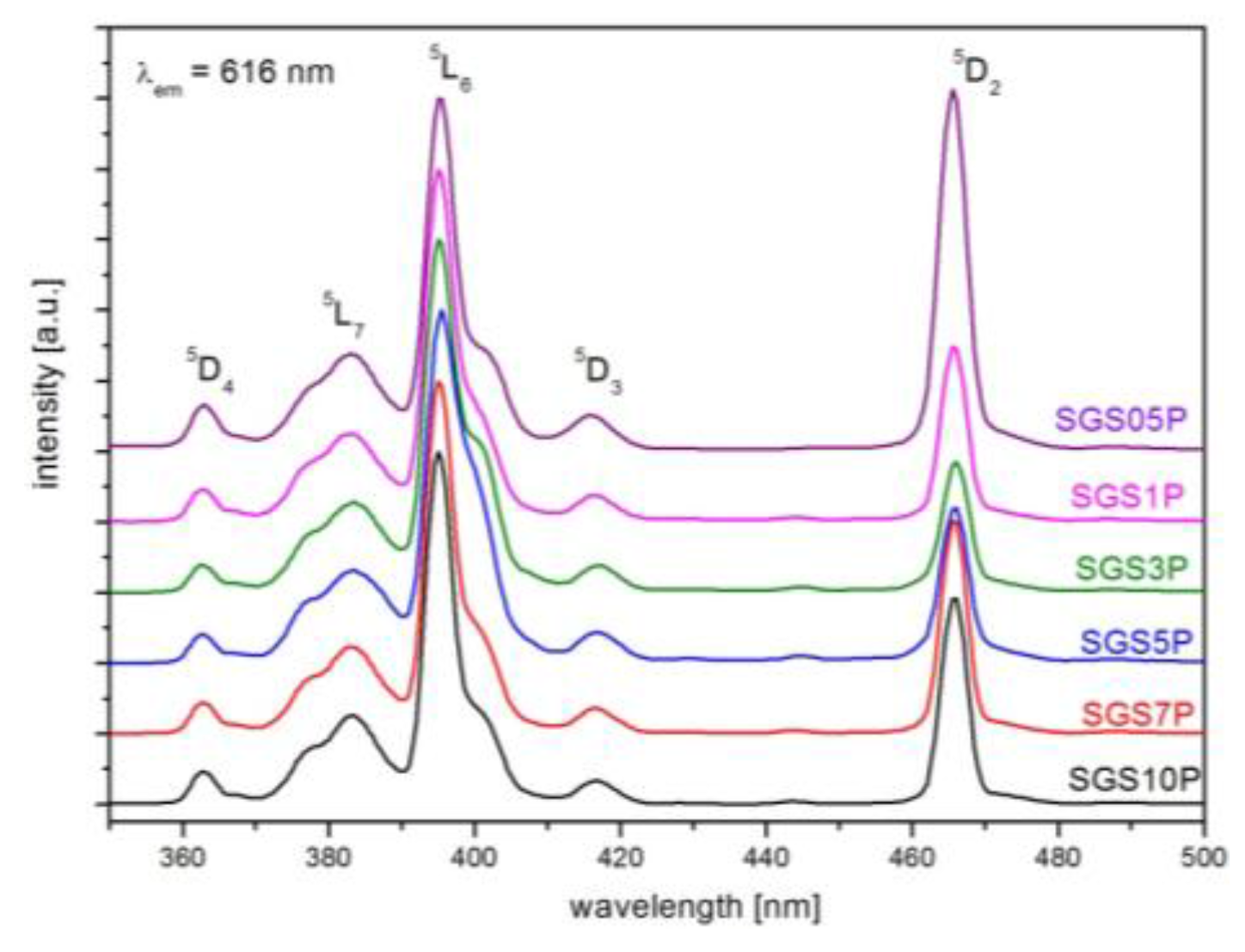
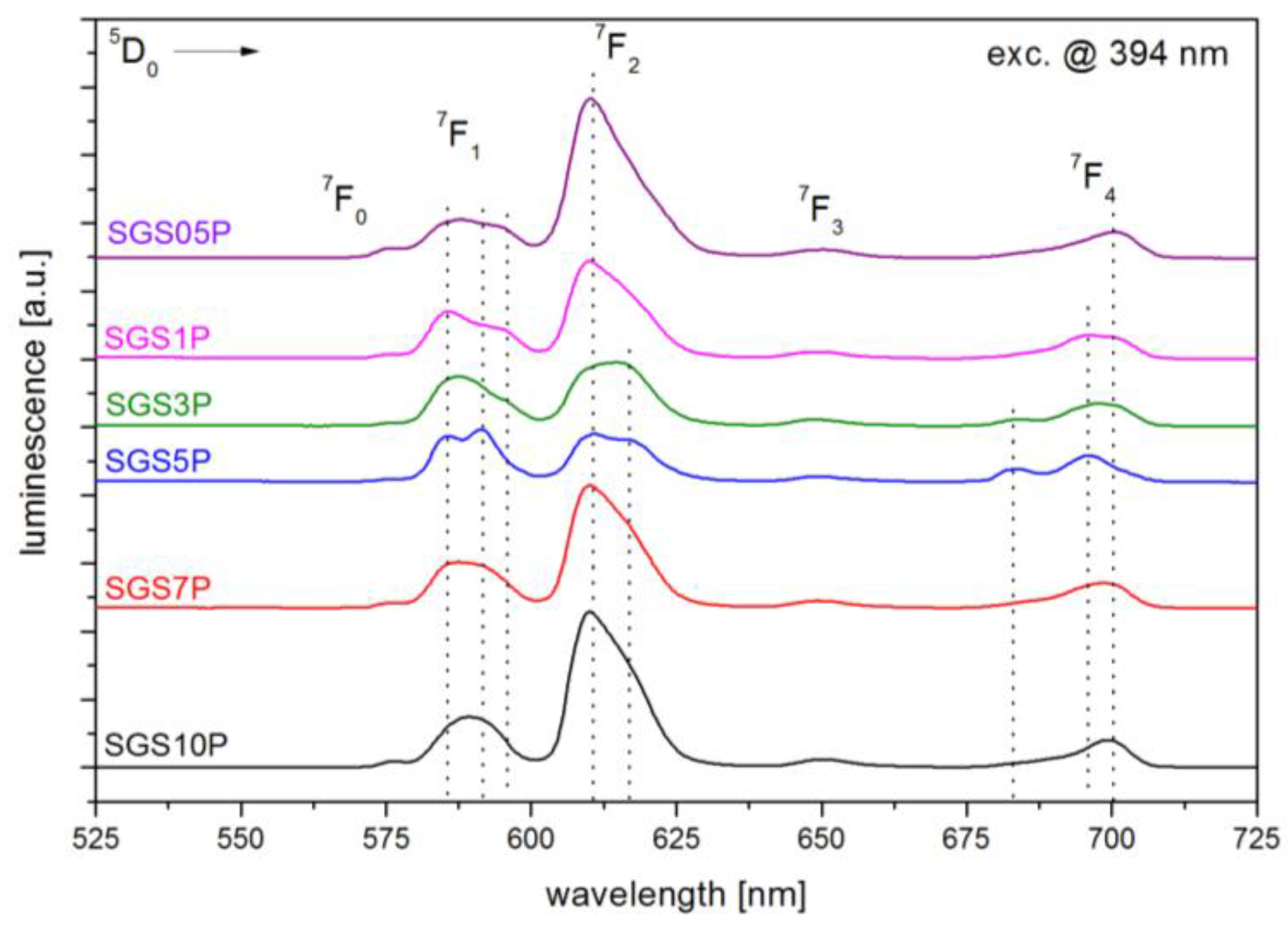
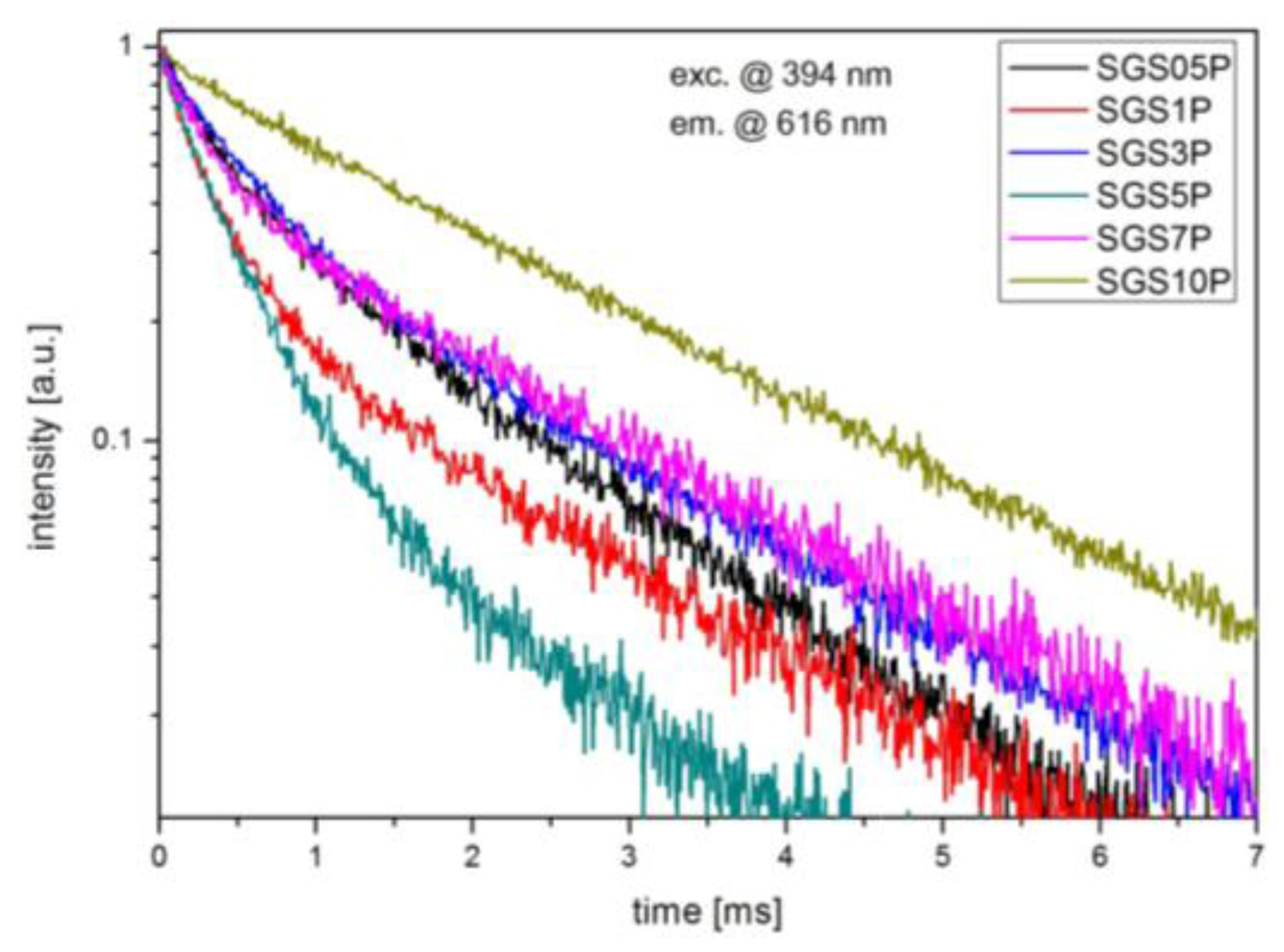
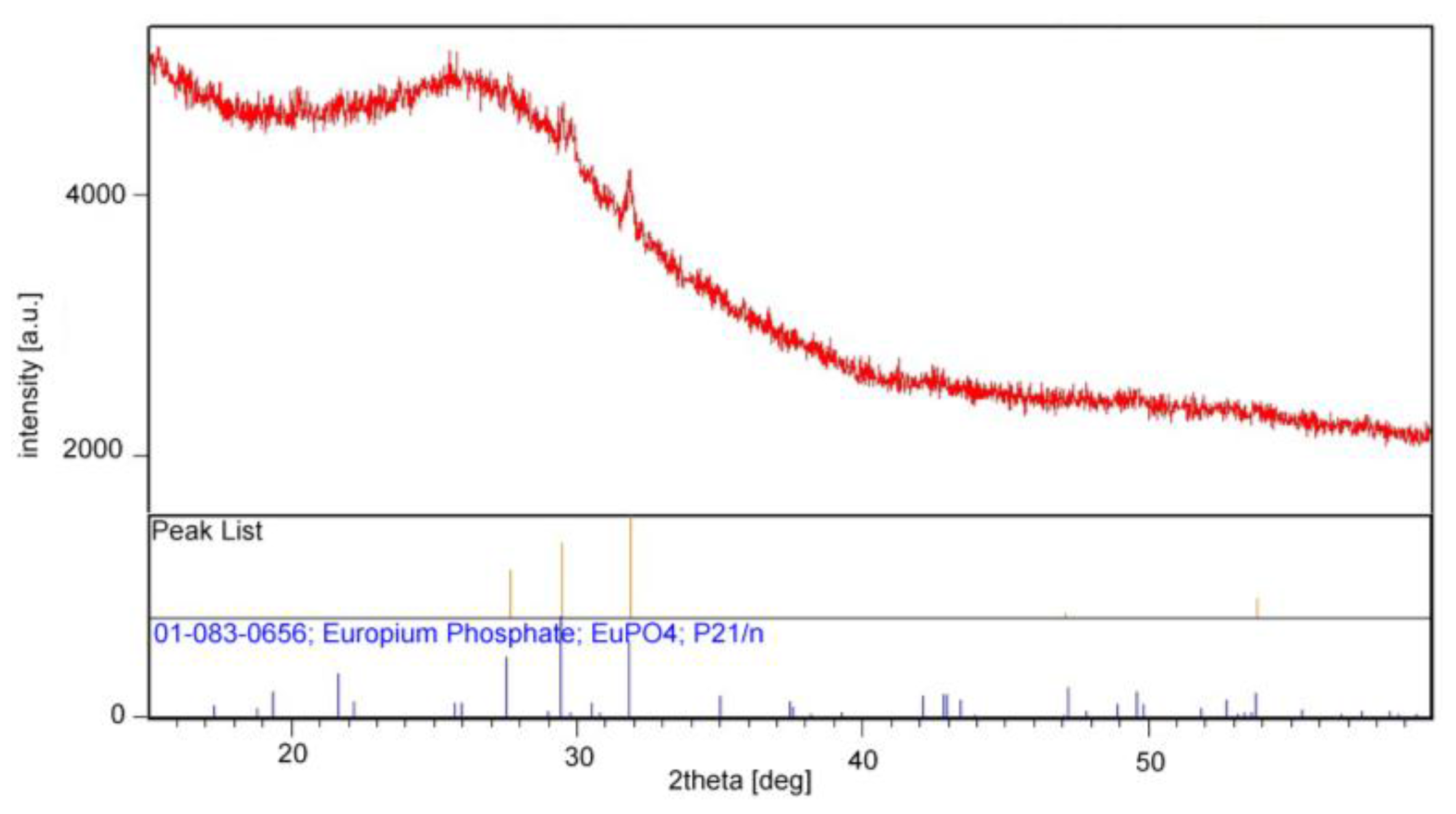
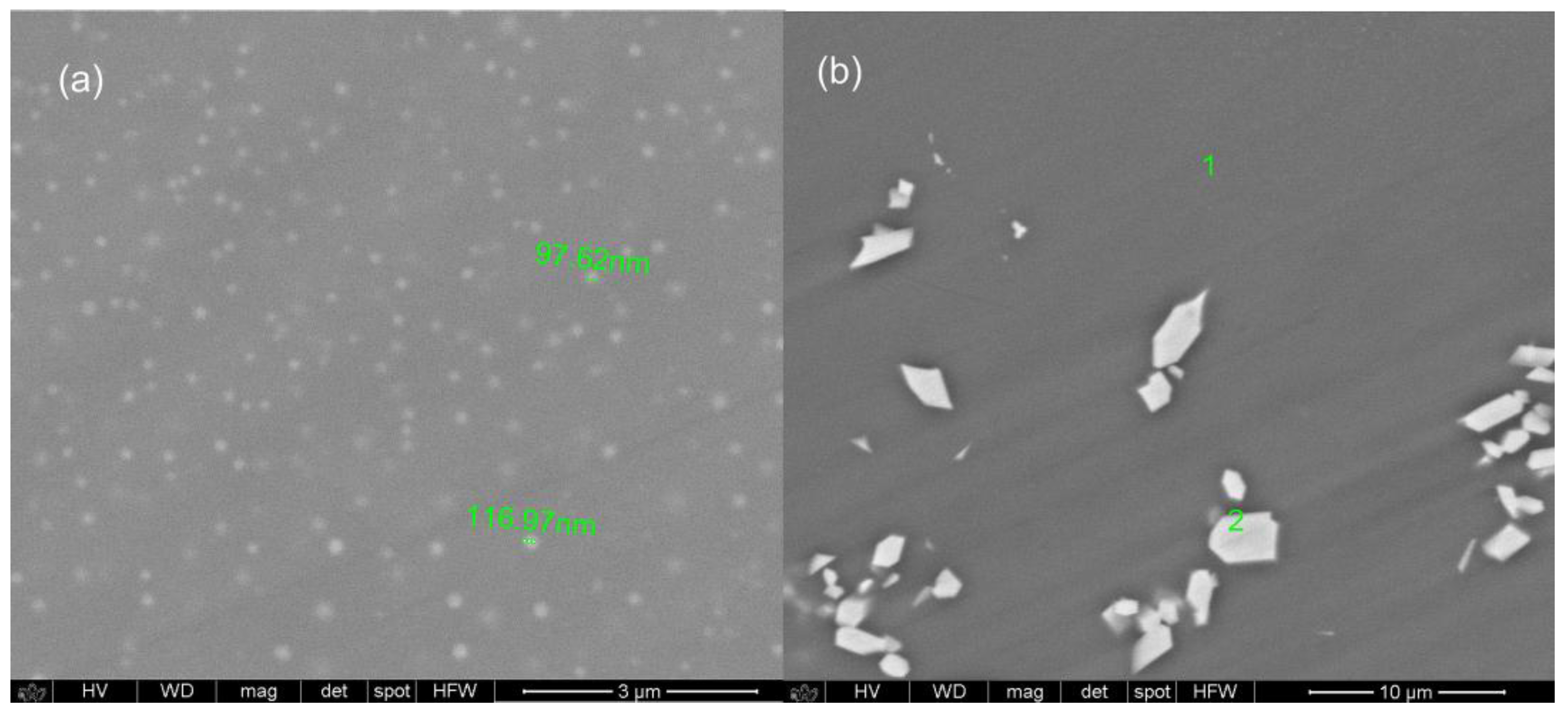
| Glass Sample | ED/MD Ratio | <τavg> [ms] |
|---|---|---|
| SGS05P | 4.24 | 1.29 |
| SGS1P | 2.02 | 1.29 |
| SGS3P | 1.27 | 1.86 |
| SGS5P | 0.92 | 0.83 |
| SGS7P | 2.66 | 1.72 |
| SGS10P | 3.03 | 1.99 |
© 2017 by the authors. Licensee MDPI, Basel, Switzerland. This article is an open access article distributed under the terms and conditions of the Creative Commons Attribution (CC BY) license (http://creativecommons.org/licenses/by/4.0/).
Share and Cite
Zmojda, J.; Kochanowicz, M.; Miluski, P.; Baranowska, A.; Pisarski, W.A.; Pisarska, J.; Jadach, R.; Sitarz, M.; Dorosz, D. Optical Characterization of Nano- and Microcrystals of EuPO4 Created by One-Step Synthesis of Antimony-Germanate-Silicate Glass Modified by P2O5. Materials 2017, 10, 1059. https://doi.org/10.3390/ma10091059
Zmojda J, Kochanowicz M, Miluski P, Baranowska A, Pisarski WA, Pisarska J, Jadach R, Sitarz M, Dorosz D. Optical Characterization of Nano- and Microcrystals of EuPO4 Created by One-Step Synthesis of Antimony-Germanate-Silicate Glass Modified by P2O5. Materials. 2017; 10(9):1059. https://doi.org/10.3390/ma10091059
Chicago/Turabian StyleZmojda, Jacek, Marcin Kochanowicz, Piotr Miluski, Agata Baranowska, Wojciech A. Pisarski, Joanna Pisarska, Renata Jadach, Maciej Sitarz, and Dominik Dorosz. 2017. "Optical Characterization of Nano- and Microcrystals of EuPO4 Created by One-Step Synthesis of Antimony-Germanate-Silicate Glass Modified by P2O5" Materials 10, no. 9: 1059. https://doi.org/10.3390/ma10091059





